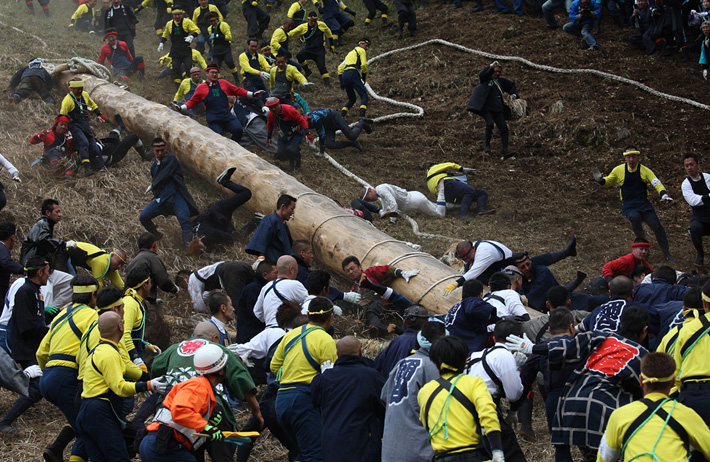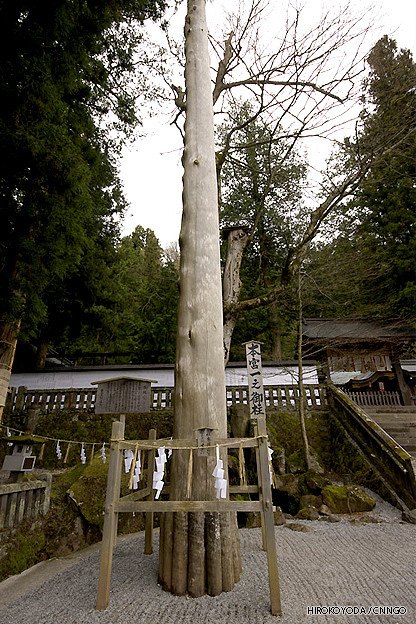Does riding down a hill on top of a giant log at high speeds sound a little bit dangerous to you? Good. Then you'll probably want to be in the audience if you ever make it to the Onbashira-sai festival, held every six years in the Lake Suwa area of Nagano, Japan. The last one was in 2010 (that means you gotta wait until 2016 to see the next one) and it drew a crowd of 500,000 people. Maybe it's a primal sort of thing, kind of like the Ancient Romans and their Colosseum. People die at this festival… like… sort of regularly. At the very least a few people come away injured. For a festival that has supposedly gone on, uninterrupted, for 1200 years… that's a lot of dead and injured log riders. Oh, and guess what's the best spot on the log? That's right, the front (which is arguably, by far, the most dangerous spot too). You won't see me volunteering any time soon.
So What's Up With The Log Riding?

I first heard about this festival in high school (that's a long time ago), and couldn't believe my ears. "This sounds radical," I probably said (we probably said "radical" a lot back then, I'm guessing). The more I read about it the more I wanted to go. I hope you get the same feeling when I tell you about Onbashira as well. This really is the greatest festival in Japan, I think.
There are actually two parts to this festival, and each part takes quite a bit of time (meaning you can party-hardy for a while if you get out here). Luckily for you and your primal side, both parts are pretty dangerous, I'd say. Let's find out what they are.
Yamadashi
The yamadashi is the first part. This means "exiting the mountains" or "coming out of the mountains." This is where you cut down 16 previously chosen trees by hand using tools from the iron age, then drag them out of the mountains for ten kilometers until you get to the Suwa Grand Shrine. This involves a lot of people, ropes, dragging, and, of course, riding. When a slope gets steep enough (and muddy/slippery enough), a few lucky team members get chosen to sit on top of the log to have the ride of their lives. You know that ride at Disneyland with the log that goes down the waterfall? This is like that, but deadly.
That's pretty insane, let's watch another one. Skip to about 8:00 for this one, unless you like a lot of foreplay with your Onbashira.

I don't think my mother would let me do this…
Each team spends approximately three days moving their 20,000 pound logs down the mountain. The goal is the Suwa Grand Shrine, where they will take these logs and replace the pillars at the four corners of the four main buildings. That brings us to the next part of the festival:
Satobiki
The satobiki is when they parade the logs through the village and to the Suwa Grand Shrine. There's people on horses, people riding the logs, and people people people. Wow, there are a lot of people. That's one of the main things this festival is known for, actually.
The idea is that by putting up new pillars every six years, the area around the shrine gets renewed spiritually (renewing and rebuilding things are both very Shinto).
Even the parading and erecting of pillars can be dangerous, too. Last time (2010), a rope snapped killing one person and injuring several others. Just when you think the terrifying part is done, too…
When all is said and done, though, you have yourself 16 new pillars and a bunch of happy people. This festival brings a ton of people to the Nagano area, which is awesome for people who enjoy traveling and cities that enjoy being traveled to. In fact, it's one of the most famous festivals in Japan. No wonder half a million people made their way here in 2010.
The next onbashira festival won't be until 2016 though, but I'm hoping to pop in for a look-see. Unfortunately, as someone who isn't a Japanese citizen, I'm not allowed to participate in any log riding (booo). But, joining the festivities and checking out the finished product is something I can do, so maybe I'll see you there.
Speaking of finished products…

Not all that amazing for all the fanfare, danger, and so on… but, I guess it's the journey, not the destination, am I right?
